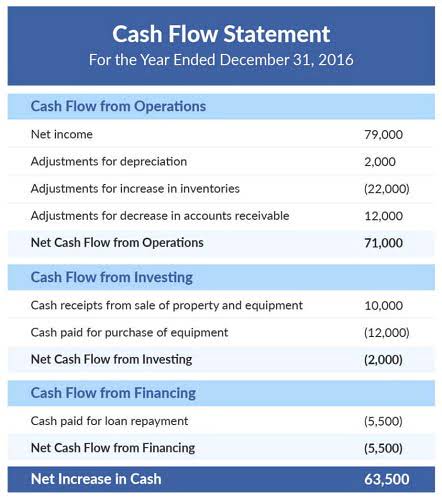Regardless of their activities, the ultimate goal of any business is to maximize profits. Keeping this in mind, there are six types of activities that all businesses have to undertake at some point or the other. The related expenses of customer service and facilities maintenance include rent, utilities, supplies, insurance and licenses.
- The adjustments reported in the operating activities section will be demonstrated in detail in “A Story To Illustrate How Specific Transactions and Account Balances Affect the Cash Flow Statement” in Part 3.
- There are more items than just those listed above that can be included, and every company is different.
- Cash flows from investing activities provide an account of cash used in the purchase of non-current assets–or long-term assets– that will deliver value in the future.
- There are no acquisitions (“Investments in Businesses”) in any of the years; however, it is there as a placeholder.
They can usually be identified from changes inthe Fixed Assets section of the long-term assets section of thebalance sheet. Some examples of investing cash flows are paymentsfor the purchase of land, buildings, equipment, and otherinvestment assets and cash receipts from the sale of land,buildings, equipment, and other investment assets. Cash flows from operating activities arise fromthe activities a business uses to produce net income.
The main benefit of a formal purchasing process is avoiding waste due to fraud, maverick spend, and other non-optimized buying habits. When looked at as a whole, the purchasing process is better described as the procure-to-pay (P2P) process. The difference between purchasing and procurement quickbooks vs wave comparison is that purchasing is actually just a part of the greater procurement process. Over 1.8 million professionals use CFI to learn accounting, financial analysis, modeling and more. Start with a free account to explore 20+ always-free courses and hundreds of finance templates and cheat sheets.
Helping organizations spend smarter and more efficiently by automating purchasing and invoice processing. Upgrading to a paid membership gives you access to our extensive collection of plug-and-play Templates designed to power your performance—as well as CFI’s full course catalog and accredited Certification Programs. Now that you have a solid understanding of what’s included, let’s look at what’s not included. This format is used for reporting Cash Flow details by finance portals like Yahoo! Finance. This format is used for reporting Cash Flow details by finance portals like MarketWatch. In Example Corporation the net increase in cash during the year is $92,000 which is the sum of $262,000 + $(260,000) + $90,000.
You can find the cash flow from operating activities on a company’s cash flow statement. You can also calculate operating cash flow by adding together a company’s net income, non-cash items (adjustments to net income), and working capital. The operating activities of a business are found in the business’ financial statements particularly the cash flow statement and the income statement.
What Is Cash Flow From Operating Activities?
Textbook content produced by OpenStax is licensed under a Creative Commons Attribution-NonCommercial-ShareAlike License . The OpenStax name, OpenStax logo, OpenStax book covers, OpenStax CNX name, and OpenStax CNX logo are not subject to the Creative Commons license and may not be reproduced without the prior and express written consent of Rice University. Harold Averkamp (CPA, MBA) has worked as a university accounting instructor, accountant, and consultant for more than 25 years. Amy Fontinelle has more than 15 years of experience covering personal finance, corporate finance and investing.
Cash flows from investing activities provide an account of cash used in the purchase of non-current assets–or long-term assets– that will deliver value in the future. Overall, the cash flow statement provides an account of the cash used in operations, including working capital, financing, and investing. Investors attempt to look for companies whose share prices are lower and cash flow from operations is showing an upward trend over recent quarters. The disparity indicates that the company has increasing levels of cash flow which, if better utilized, can lead to higher share prices in near future.
The Financial Accounting Standards Board (FASB) recommends that companies use the direct method as it offers a clearer picture of cash flows in and out of a business. Many accountants prefer the indirect method because it is simple to prepare the cash flow statement using information from the income statement and balance sheet. Most companies use the accrual method of accounting, so the income statement and balance sheet will have figures consistent with this method.
We and our partners process data to provide:
Following a set purchasing process is helpful, but it doesn’t solve all of your procurement headaches. To level up your purchasing process into a well-oiled machine, it’s helpful to follow the best practices laid out below. Manual workflows and paper-based record-keeping are no longer sufficient for modern purchasing processes. Procurement software and automation have eliminated the challenges that come with these outdated methodologies.
In financial modeling, it’s critical to have a solid understanding of how to build the investing section of the cash flow statement. The main component is usually CapEx, but there can also be acquisitions of other businesses. Investors should be aware of these considerations when comparing the cash flow of different companies. The first option is the indirect method, where the company begins with net income on an accrual accounting basis and works backwards to achieve a cash basis figure for the period. Under the accrual method of accounting, revenue is recognized when earned, not necessarily when cash is received.
Accounting Records Update
There are more items than just those listed above that can be included, and every company is different. The only sure way to know what’s included is to look at the balance sheet and analyze any differences between non-current assets over the two periods. Any changes in the values of these long-term assets (other than the impact of depreciation) mean there will be investing items to display on the cash flow statement. Cash flow from operating activities does not include long-term capital expenditures or investment revenue and expense.
Along with following the best pratices above, using the right tools to automate and streamline the purchasing process will help you derive the most value. Extracting the maximum value from the purchasing process requires care and skill—especially in a competitive and fast-moving global marketplace. The steps in the purchasing process are a cycle, with each step requiring information to be exchanged and either internal or external approval to move forward.
Cash flows related to changes in equity can beidentified on the Statement of Stockholder’s Equity, and cash flowsrelated to long-term liabilities can be identified by changes inlong-term liabilities on the balance sheet. Cash flows from financing activities are cash transactions related to the business raising money from debt or stock, or repaying that debt. Cash flows related to changes in equity can be identified on the Statement of Stockholder’s Equity, and cash flows related to long-term liabilities can be identified by changes in long-term liabilities on the balance sheet. Cash Flow from Investing Activities is the section of a company’s cash flow statement that displays how much money has been used in (or generated from) making investments during a specific time period. Investing activities include purchases of long-term assets (such as property, plant, and equipment), acquisitions of other businesses, and investments in marketable securities (stocks and bonds). Assume you are the chief financial officer of T-Shirt Pros, a small business that makes custom-printed T-shirts.
Along with this, it purchased $5 billion in investments and spent $1 billion on acquisitions. To calculate the cash flow from investing activities, the sum of these items would be added together, to arrive at the annual figure of -$33 billion. Inventories, tax assets, accounts receivable, and accrued revenue are common items of assets for which a change in value will be reflected in cash flow from operating activities.
T-Shirt Pros’ statement of cash flows, as it was prepared by thecompany accountants, reported the following for the period, and hadno other capital expenditures. Net income is typically the first line item in the operating activities section of the cash flow statement. This value, which measures a business’s profitability, is derived directly from the net income shown in the company’s income statement for the corresponding period. T-Shirt Pros’ statement of cash flows, as it was prepared by the company accountants, reported the following for the period, and had no other capital expenditures. The principal operating activities include any cash flows that relate to the core or activity that business performs to earn a profit. However, negative cash flow from investing activities might be due to significant amounts of cash being invested in the long-term health of the company, such as research and development.
For example, a tax accountant might organize introductory training sessions for small businesses at the local chamber of commerce. There are two primary revenue-generating https://www.wave-accounting.net/ activities of businesses – providing services and selling products. Next, assume that Example Corporation distributed $110,000 of cash dividends to its stockholders.






